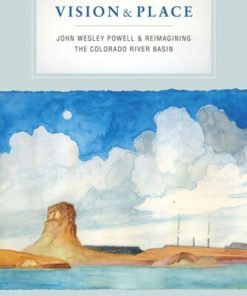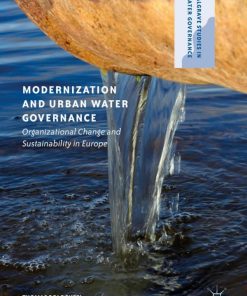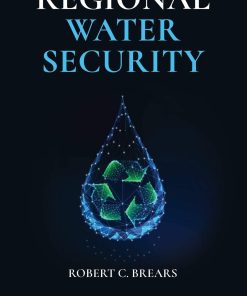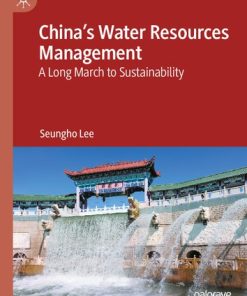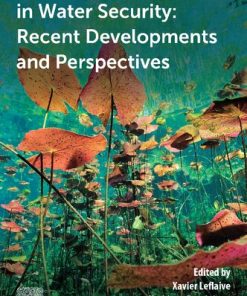Indus River Basin Water security and sustainability 1st edition by Sadiq Ibrahim Khan 012812783X 9780128127834
$50.00 Original price was: $50.00.$25.00Current price is: $25.00.
Indus River Basin. Water security and sustainability 1st edition by Sadiq Ibrahim Khan 012812783X 9780128127834 – Ebook PDF Instant Download/DeliveryISBN:
Full download Indus River Basin. Water security and sustainability 1st edition after payment.
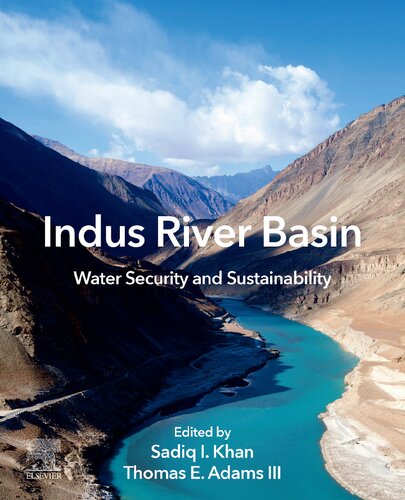
Product details:
ISBN-10 : 012812783X
ISBN-13 : 9780128127834
Author : Sadiq Ibrahim Khan
Indus River Basin: Water Security and Sustainability provides a comprehensive treatment of water-related issues within the Indus River basin. Each chapter is written by an expert in the field, hence this book serves as a single, holistic source covering the whole region, not just a single country. Many of the challenges faced by this region are trans-boundary issues, especially within the context of climate change and water scarcity. Topics covered include extreme engineering and water resource management (one of the largest irrigation systems in dry to semi-desert conditions), social sciences (population dynamics linked to water resources) and political sciences.
Indus River Basin. Water security and sustainability 1st Table of contents:
Part I: Indus River Basin-Past, Present and Future
Introduction: Introduction of Indus River Basin: Water Security and Sustainability
1. Indus River Basin
2. A Historical Perspective of the IRB
3. Synopsis of This Book
3.1. Part I-Indus River Basin-Past, Present, and Future
3.2. Part II-Climate-Ecohydrology of Indus River Basin
3.3. Part III-Water and Food Security of Indus River Basin
3.4. Part IV-Water Extremes in Indus River Basin
3.5. Part V-Water Management in Indus River Basin
References
Further Reading
Chapter 1: Water Resources Modeling and Prospective Evaluation in the Indus River Under Present and
1.1. Introduction
1.1.1. Water Resources of the Hindu Kush, Karakoram, and Himalaya
1.1.2. The Karakoram Anomaly
1.2. Climate and Hydrology of the Upper Indus Basin
1.3. Summary of Recent Studies
1.3.1. Hydrological Regime of the UIB
1.3.2. Recent Evidence of Climate Change and Impact on Water Resources in the UIB
1.3.3. Projected Water Resources in the UIB During the 21st Century
1.4. A Guideline and Recent Key Study on Monitoring and Modeling High-Altitude Catchments
1.4.1. A Method to Model High-Altitude Catchments
1.4.2. A Paradigmatic Case Study, Shigar River of Gilgit-Baltistan
1.4.2.1. The Shigar River
1.4.2.2. Data for High-Altitude Catchment Modeling
1.4.2.3. Glacio-Hydrological Modeling in High-Altitude Catchments
1.4.2.4. Future Hydrology of the Shigar River
1.4.2.5. Future Cryospheric Behavior in the Shigar River
1.4.2.6. Potential for Increased Floods Within the UIB: The Case of Shigar River
1.5. Discussion
1.5.1. Hydrological Trends Within the UIB
1.5.2. The Need for Hydrological Monitoring in the UIB
1.5.3. A Proposed Hydrometric Network for the CKNP
1.6. Conclusions
Acknowledgments
References
Further Reading
Chapter 2: Challenges in Forecasting Water Resources of the Indus River Basin: Lessons From the Anal
2.1. Introduction
2.2. Lessons From Atmospheric Models
2.2.1. Skillful Prediction
2.2.2. Prediction Skill and Model Biases
2.2.3. Spring Snow Over Eurasia
2.2.4. The Effect of Resolution
2.2.5. Multidecadal Timescales
2.3. Lessons From Uncertainty
2.3.1. The Complexity of Uncertainty
2.3.2. Uncertainty in Downscaled Output
2.3.2.1. Assessing Uncertainty: A Case Study
2.3.2.2. Investigating Seasonal Changes in the Case Study
2.3.2.3. Is Cooling a Plausible Result?
2.3.3. Heterogeneity in the Estimates
2.3.4. Projections of Climate Extremes
2.4. Lessons From Hydrological Projections
2.4.1. Cascade of Uncertainty
2.4.2. Overview of a Few Hydrological Studies
2.4.2.1. Results from NORINDIA
2.4.2.2. The Role of Glacier Melt
2.5. Conclusion
Appendix A. The NORINDIA Project in a Nutshell
A. Case Study of the Beas River System
B. Assessment of the CFSR Reanalysis Product
Appendix B. Dynamical Downscaling of NorESM and ERA-Interim Data Sets
Appendix C. Bayesian Method for Estimating the Mean Surface Temperature
Acknowledgments
References
Chapter 3: Past and Future Glacier Changes in the Indus River Basin
3.1. Introduction
3.2. Past Glacier Changes
3.2.1. Area and Length Changes
3.2.2. Mass Changes
3.3. Future Trends
3.4. Discussion and Conclusions
Acknowledgments
References
Part II: Climate-Eco-Hydrology of Indus River Basin
Chapter 4: Probabilistic Precipitation Analysis in the Central Indus River Basin
4.1. Introduction
4.2. Data and Methods
4.2.1. Study Area
4.2.2. In Situ Observations
4.2.3. Atmospheric Reanalyses
4.3. Application of the Model Conditional Processor
4.3.1. Predictive Uncertainty
4.3.2. Normalization of Variables
4.3.3. Precipitation: Normal Distributions
4.3.4. Back-Transformation Into the Original Space
4.4. Application and Results
4.4.1. Calibration
4.4.2. Performance Indicators
4.4.3. Validation
4.5. Conclusions
Acknowledgments
Appendix. The Model Conditional Processor
References
Chapter 5: Glaciers in the Indus Basin
5.1. Introduction
5.2. Data and Methodology
5.3. Glacier Characteristics in the Indus Basin
5.3.1. Number, Area, and Estimated Ice Reserves
5.3.2. Glacier Area Classes
5.3.3. Glacier Elevation
5.3.4. Aspects
5.3.5. Slope
5.3.6. Morphological Glacier Type
5.3.7. Clean-Ice and Debris-Covered Glaciers
5.3.8. Hypsography
5.4. Conclusions
Acknowledgments
References
Further Reading
Chapter 6: A Review on the Projected Changes in Climate Over the Indus Basin
6.1. Introduction
6.2. Climate Projection in the Indus Basin
6.2.1. Projected Temperature Trends
6.2.2. Projected Precipitation Trends
6.3. Conclusion
Acknowledgments
References
Chapter 7: A Hydrological Perspective on Interpretation of Available Climate Projections for the Upp
7.1. Introduction
7.2. Initial Analysis of Ground-Based Data
7.2.1. Precipitation
7.2.2. Temperature
7.3. Hydrological Regimes and Climate Runoff Relationships
7.4. Evaluation and Interpretation of Available Climate Projections for the UIB
7.5. Available Methods for Downscaling GCM Projections to Finer Spatial Scales
7.6. Evaluation of Outputs From Available RCM Historical Period Simulations
7.6.1. RCM Skill in Representation of Large-Scale Climate
7.6.2. RCM Skill in Representation of the UIB-Karakoram Climate
7.7. Vertical Patterns of Projected UIB Climate Change From CORDEX-South Asia
7.8. Summary and Priorities for Further Research on the UIB’s Future Climate
References
Part III: Water and Food Security of Indus River Basin
Chapter 8: Transboundary Indus River Basin: Potential Threats to Its Integrity
8.1. Introduction
8.2. Water Sharing Mechanism in Practice
8.3. Indus River Basin and Regional Economy
8.4. Emerging Threats to the Indus River Basin
8.4.1. Growing Population
8.4.2. Reduced or Fluctuating Surface Flows
8.4.3. Reduced Environmental Flows
8.4.4. Accelerated Water Scarcity
8.4.5. Rising Water Demand
8.4.6. Lower Land and Water Productivity
8.4.7. Groundwater Quantity and Quality
8.4.8. Hydropower Generation and Energy Crisis
8.4.9. Climate Change
8.4.10. Aging Treaty
8.5. Conclusions
References
Further Reading
Chapter 9: Indo-Ganges River Basin Land Use/Land Cover (LULC) and Irrigated Area Mapping
9.1. Introduction
9.2. Study Area
9.3. Data
9.3.1. Satellite Data
9.3.2. Ground Data
9.3.3. Ideal Spectra Signatures
9.3.4. Mapping Land Use/Land Cover
9.3.5. Matching Class Spectra With Ideal Spectra to Group Classes Using Spectral Matching Techniques
9.3.6. Subpixel Area Calculations
9.3.7. Accuracy Assessments
9.4. Results and Discussions
9.4.1. Spatial Distribution of Croplands in Indo-Ganges Basin
9.4.2. Spatial Distribution of Irrigated and Rainfed Croplands in the Indo-Ganges Basin
9.4.3. Class Signatures and Onset-Peak-Senescence-Duration of Crops
9.4.4. Accuracies and Errors
9.4.5. Comparison With District Wise Cropland Statistics
9.4.6. Discussion of Methods
9.5. Conclusions
References
Chapter 10: Increasing Water Productivity in the Agricultural Sector
10.1. Introduction
10.2. Concepts of Water Productivity
10.3. Agricultural Water Productivity Across the Globe
10.4. Opportunities for Increasing Water Productivity in Agriculture Sector
10.4.1. Plant-Scale Interventions
10.4.2. Field-Scale Interventions
10.4.3. Irrigation System-Scale Interventions
10.4.4. Basin-Scale Interventions
10.5. Conclusions
References
Chapter 11: Hydrological Cycle Over the Indus Basin at Monsoon Margins: Present and Future
11.1. Introduction
11.2. Data and Methods
11.2.1. Data
11.2.2. Methods
11.3. Results and Discussion
11.3.1. Observed Precipitation
11.3.2. Physical Consistency and Realism of CMIP5 Experiments
11.3.3. Future Water Budget Changes
11.4. Conclusions
Acknowledgments
References
Part IV: Water Extremes in Indus River Basin
Chapter 12: Water Resources Forecasting Within the Indus River Basin: A Call for Comprehensive Model
12.1. Introduction
12.1.1. Necessity for Hydrological Services
12.1.1.1. Pakistan’s Needs
12.1.2. Hydro-Climatology
12.1.3. Flooding
12.1.4. Irrigation and Water Resources
12.2. Status of Hydrometeorological Monitoring
12.3. Status of Hydrological Modeling and Forecasting
12.3.1. Pakistan
12.3.2. India
12.3.3. China
12.3.4. Afghanistan
12.4. Needed Improvements and Benefits
12.4.1. Infrastructure Improvements
12.4.2. Improved Capacity Building and Coordination
12.4.3. Hydrological Modeling Improvements
12.5. Conclusions
References
Further Reading
Chapter 13: Review of Hydrometeorological Monitoring and Forecasting System for Floods in the Indus
13.1. Introduction
13.2. Floods in the Indus Basin
13.3. Hydrometeorological Observation/Monitoring System of Pakistan
13.3.1. Hydrometeorological Observation by PMD
13.3.1.1. Manual Rainfall Observations
13.3.1.2. Automatic Rainfall Observations
13.3.1.3. Upper-Air Observations
13.3.1.4. Weather Radar
13.3.2. Hydrometeorological Stations of WAPDA and Other Organizations
13.3.3. Hydrometeorological Network and System in the Indus Operated by India
13.3.4. Mechanisms for Collecting and Processing Hydrometeorological Data
13.3.4.1. Processing and Release of Meteorological Data
13.4. Flood Forecasting in Pakistan
13.4.1. Numerical Weather Prediction (NWP)
13.4.2. Flood Forecasting Models Used by FFD
13.4.3. Real-Time Flood Monitoring and Dissemination
13.5. Looking Ahead
References
Chapter 14: Flood Monitoring System Using Distributed Hydrologic Modeling for Indus River Basin
14.1. Introduction
14.2. Advances in Flood Forecasting Systems
14.3. Hydrological Modeling Framework
14.3.1. Hydrometeorological and Geospatial Data Sets
14.3.1.1. Observed Daily Streamflow
14.3.1.2. Quantitative Precipitation Estimates (QPE)
14.3.1.3. Quantitative Precipitation Forecast (QPF)
14.3.2. Distributed Hydrological Modeling
14.4. Indus River Basin Flood Monitoring System
14.4.1. Hydrologic Model Evaluation Metrics
14.4.2. Distributed Model Simulations
14.5. Discussion and Conclusion
References
Chapter 15: Annual Flood Monitoring Using Synchronized Floodwater Index in 2010 Indus River Flood
15.1. Introduction
15.1.1. Background
15.1.2. Operational Flood Monitoring: Rapid Mapping System
15.2. Study Area
15.3. Data Used
15.4. Research-Based Flood Monitoring and Mapping
15.4.1. Multisatellite-Derived Flood Mapping
15.4.2. The Synchronized Multiple-Floodwater Index
15.4.3. Flood Map Validation
15.5. Results
15.5.1. Long-Term Annual Flood Mapping
15.5.2. Flood Map Comparison and Validation
15.6. Discussion
15.6.1. Improvements
15.6.2. Challenges
15.7. Conclusions
Acknowledgments
References
Further Reading
Part V: Water Management in Indus River Basin
Chapter 16: Water Management in the Indus Basin in Pakistan: Challenges and Opportunities
16.1. Surface Water Availability
16.2. Institutional Setup
16.3. River Water Distribution at Basin Scale
16.4. Historical Perspective
16.4.1. Water Apportionment Accord
16.5. Distribution at Provincial Scale
16.6. Distribution at Canal Command
16.7. Distribution at Watercourse Command
16.8. Efforts to Improve Distribution Equity
16.8.1. Program Monitoring and Implementation Unit-Punjab
16.9. Challenges and Opportunities
16.9.1. Surface Storages
16.9.2. Improving Water Allocation
16.9.2.1. The IBIS Scale
16.9.2.2. Provincial Scale
16.9.2.3. Canal Command Scale
16.9.3. Inequitable Distribution
16.9.3.1. Watercourse Command Scale
16.9.4. Transboundary Water Issues
16.9.5. Waterlogging and Salinity Issues
16.9.6. Improving Water Use Efficiency at Field Scale
16.9.6.1. Promoting High Efficiency Irrigation Systems
16.9.7. Water Pollution and Treatment
16.9.7.1. Domestic Sector
16.9.7.2. Agriculture and Industrial Sector
16.9.7.3. Water Treatment at Source
16.9.8. Water Supply Sustainability in Mega Cities
16.10. Conclusions
References
Chapter 17: Integrated Irrigation and Agriculture Planning in Punjab: Toward a Multiscale, Multisect
17.1. The Problem of Resource Management in the Indus River Basin
17.2. IWRM and Nexus Thinking
17.3. History of Integration in the Indus River Basin
17.4. Irrigated Agriculture Planning in Punjab Today
17.4.1. Multiscale Planning
17.4.1.1. Irrigation
17.4.1.2. Agriculture
17.4.2. Multiscale and Cross-Sectoral Planning
17.5. Reimagining Planning of Irrigated Agriculture in Punjab
17.5.1. Empower the Meso Scale to Create Local Plans
17.5.2. Boundary Spanning for Integrated Planning
17.5.3. Boundary Spanning Objects for Integrated Planning
17.6. Conclusions
References
Further Reading
Chapter 18: Developing Groundwater Hotspots: An Emerging Challenge for Integrated Water Resources Ma
18.1. Integrated Water Resources Management
18.2. Groundwater Depletion and Emerging Hotspot Areas
18.2.1. Urban Areas
18.2.2. Agricultural Areas
18.3. Waterlogging and Salinity-Still a Consistent Threat
18.4. Integration Needs: Surface Water-Groundwater Nexus in Pakistan
18.4.1. Spatial Variation in Water Demand and Supply
18.4.2. Spatial Variation in Rainfall
18.5. Reallocation-A Challenge in Itself, and the Only Option
18.5.1. System-Scale Smart Surface Water Reallocation
18.6. Recommended Innovations
18.6.1. Groundwater Governance
18.6.1.1. Urban Sector: Volume-Based Water Charging
18.6.1.2. Industrial Sector
18.6.1.3. Agricultural Sector
18.6.1.4. Managing Cropping Intensities and Patterns
18.7. Conclusions and Recommendations
References
Further Reading
Chapter 19: Quantitative Estimation of Resource Linkages in Water Infrastructure Planning
19.1. Introduction
19.2. Concept of River Basin Resource Linkages
19.3. Indus Basin Resources
19.3.1. The People and the Land
19.3.2. The Climate and the Water Resources
19.3.3. Energy
19.3.4. Irrigation and Food Production
19.4. Resource Linkages
19.4.1. Water Links the Basin’s Other Resources
19.4.2. Indus Basin Has Strong Upstream-Downstream Linkages
19.4.3. Water and Energy Links Are Strong
19.4.4. Human Migration Is Linked With Water Stress
19.4.5. Irrigation and Urban Water Uses Are in Competition
19.4.6. Change in Land Use Impacts the Water Availability
19.4.7. Climate Change Has Overwhelming Effect on the Natural Resource System
19.4.8. Transboundary Issues and Hydro-Politics Affect the Basin’s Services
19.5. Water Infrastructure Planning
19.5.1. Context of WIP
19.5.2. Infrastructural Development in the History
19.5.3. Guiding Principles for the Water Infrastructural Planning
19.6. Quantitative Estimation of the Resource Linkages
19.6.1. Assessment Tools
19.6.2. The Quantification Challenges
19.6.3. The Quantification Guidelines
19.7. Conclusions
People also search for Indus River Basin. Water security and sustainability 1st:
indus river basin states
indus river basin is extended up to in india
indus river basin area
indus river basin upsc
indus river basin area in india
Tags: Indus River Basin, Water security, sustainability, Sadiq Ibrahim Khan
You may also like…
Business & Economics - Investing
Earth Sciences - Geology
Engineering - Environmental
Engineering - Environmental
China’s Water Resources Management: A Long March to Sustainability





